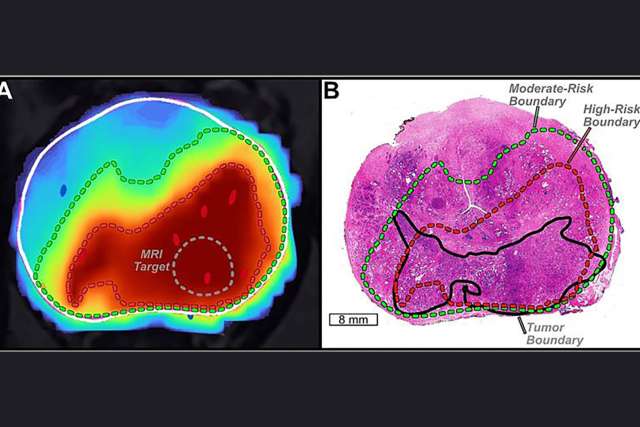When Jose Hernandez was told by his UCLA Health medical team that he had developed another aortic aneurysm he feared the risks of cutting into his chest and abdomen, yet again, for a major surgery.
Hernandez, 58, has a rare genetic condition that causes weaker blood vessels, making him susceptible to life-threatening aneurysms or abnormal bulges in his aorta. The aorta, which starts in the heart, is the largest artery in the body and supplies blood to all organs and systems. He was informed that if he wanted to delay surgery for a few weeks, an international leader in a safer, less invasive procedure would soon be joining UCLA Health.
Hernandez decided to hold out for the arrival of aortic surgeon Bernardo Mendes, MD, who left the Mayo Clinic to become co-director of the UCLA Health Aortic Center in May 2025. Soon after his arrival, Dr. Mendes performed a complex endovascular aortic repair on Hernandez.
“I was just praying for Dr. Mendes to get to UCLA,” said Hernandez, who lives in South Gate. “Finally, they told me, ‘The doctor is here and he wants to see you.’ I really appreciate him and all the team. I’m alive and enjoying life.”
A different approach
Hernandez had needed to have a colonoscopy, but first he underwent an abdominal CT scan to ensure that the procedure would be safe given his propensity to develop aneurysms. It was the scan that revealed an aneurysm in the part of his aorta passing through his abdomen. If it ruptured or split it could cause internal bleeding or block blood flow to vital organs.
This was his seventh aortic aneurysm. For the previous six, surgeons cut open his chest, abdomen and back. Hernandez jokes that the large scars resemble freeways.
He said he was relieved to learn about Dr. Mendes and a recently approved medical device that would allow for endovascular surgery. Instead of making a large incision through the chest and stomach for a traditional “open surgery,” Dr. Mendes made tiny cuts in Hernandez’s groin and arm.
He used a catheter, guided by imaging, to insert a specialized stent to maintain blood flow to his abdominal organs, while sealing the aneurysm so it wouldn’t burst.
The branched stent graft, called TAMBE (Thoracoabdominal Branch Endoprosthesis), was approved by the Food and Drug Administration in 2024, but Dr. Mendes had extensive experience using the device during earlier clinical trials.

TAMBE is designed to treat aneurysms in the area of the aorta involving branch vessels to the kidneys, intestines and liver. That location made Hernandez’s aneurysm very complex, Dr. Mendes said, as did the condition of his aorta, which had mostly been replaced by grafts during previous surgeries.
“The multiple previous operations resulted in a very distorted and unique anatomy,” Dr. Mendes said.
The surgery lasted about four hours. Dr. Mendes said a traditional open surgery would have taken on average at least eight or 10 hours. Hernandez’s blood is now routed inside the stent and through its branches to his liver, kidneys and intestines.
“If it wasn’t for this stent then there would be no other commercially available option in the U.S. that could treat his anatomy,” Dr. Mendes said. “A few years ago, he wouldn’t have been able to be treated endovascularly.”
Hernandez spent a week in the hospital for recovery and monitoring. Dr. Mendes said typical stays are four or five days after the procedure instead of up to two weeks with a more invasive operation.
“It was quick. It was less pain. I could walk faster. The recovery was better than the other surgeries,” Hernandez said.
Life-threatening aneurysms
Hernandez was born in Mexico City, the sixth of 12 children. He moved to Southern California as a young adult. One day when he was 28, Hernandez felt like he couldn’t breathe while eating a meal. He thought he was choking and his wife called 911.
In fact, he was experiencing an aortic dissection, which is a tear in the inner layer of his aorta. The location, where the aorta exited his heart, was causing heart failure.
He underwent emergency surgery to repair the aneurysm and replace the aortic valve with a mechanical valve.
He was later diagnosed with Marfan syndrome, a condition affecting roughly 1 in 5,000 people. Those with Marfan syndrome have a gene mutation that limits the body’s ability to make proteins needed to build the connective tissue that supports the body and organs. They are often tall and slender, with long limbs, fingers and toes. Hernandez is about 6-foot-2.
When Hernandez was a teenager, his father died of an apparent heart attack. He now suspects that his father, who was also tall and thin, had undiagnosed Marfan syndrome.
Hernandez had a young son at the time of his diagnosis. The family later learned that his son also has Marfan syndrome, but his case is far less severe and he has never needed surgery. One of Hernandez’s brothers and a nephew have also tested positive for the condition.
Over the years, Hernandez developed more aortic aneurysms and dissections and underwent intensive surgeries. The recoveries were lengthy and painful, with hospital stays as long as a month. Dr. Mendes said the repeated aneurysms are not unusual in severe cases.
“It’s not that these operations failed, it’s just that the nature of the disease is any remaining segment of aortic tissue that stays in there after an operation is subject to further degeneration and can become an aneurysm down the road,” Dr. Mendes said.
Always learning and advancing
Dr. Mendes, professor of vascular and endovascular surgery at the David Geffen School of Medicine at UCLA, said he was excited to bring his expertise in complex endovascular aortic surgery, while continuing to pursue his interest in research and new technology.
“Every day I’m learning something new or developing something new or understanding things in a newer way compared to before,” he said. “You can accomplish things with a minimally invasive approach that you couldn’t do before. It’s exciting because we can be at the forefront of that endovascular revolution by providing this treatment for patients and participating in the clinical trials.”
Dr. Mendes, who holds the Wesley S. Moore, MD, Endowed Chair in Endovascular Surgery, said he enjoys the technical challenge of providing very specialized care, such as in Hernandez’s case.
“When I met him the first time, he told me, ‘UCLA has already saved me so many times. I’m so thrilled that you are here and you can save me again,’” he said. “When I can provide a treatment that is extremely effective and extremely complex, it is very rewarding.”
That is a goal of the UCLA Health Aortic Center, which brings together multiple specialists, including cardiac surgeons, radiologists and geneticists, to meet the needs of patients with unique problems and anatomy.
“There are not many institutions in the world that can do this work at such a high level,” Dr. Mendes said. “You need perfect anesthesia, perfect ICU care, perfect pre-operative planning. I’m just one piece of the puzzle.”
A brighter future
Hernandez will continue to undergo monitoring by UCLA Health’s cardiac and vascular teams to ensure his stents are keeping good blood flow in his vessels.
“He’s doing perfect,” Dr. Mendes said. “No complications. No residual symptoms. Doing this operation certainly prolonged his life expectancy.”
Hernandez said he’s feeling great. He has a follow-up appointment scheduled with Dr. Mendes in early 2026.
“It’s been rough, but life is so beautiful,” Hernandez said. “Sometimes we don’t appreciate what we have. I’m thankful for all the people over these years, the doctors and the nurses, getting me the help I need.”



